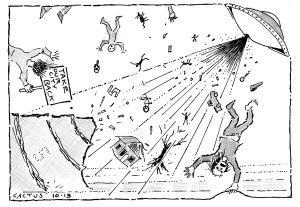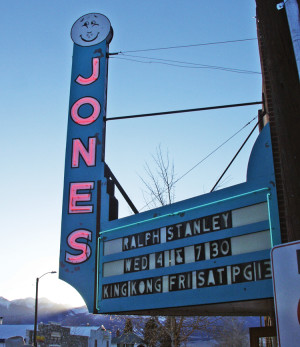By Forrest Whitman
When Gov. Hickenlooper visited Colorado Central county in Salida this summer, he took time out to view the old D. & R. G. W. Railroad main line. The last time a scheduled freight rolled by there was in 1997, but surprisingly we heard a horn blast. There it was, no mistaking, the short, long and two shorts of a train approaching the grade crossing in Salida. It turned out to be a maintenance-of-way consist. The crew dedicated some hours to removing any large plants growing up between the ties and moving some rocks off the line. The Union Pacific (UP) was complying with their obligation to keep the tracks open, even though they are officially “out of service.” As we looked over the much neglected tracks, I reminded the governor of a bit of history.
The official state rail plan includes the old main line from Pueblo to Minturn (over Tennessee Pass). Hick knew that, he said. Whether the UP thinks of it as an important line is anyone’s guess, but it is important for one big reason: It’s the railroad that can miss the floods. When the Moffat tunnel goes down, or if South Boulder Creek or Coal Creek floods badly, there’s no longer any way to move trains on the UP main line across the Rockies. These last big floods did close those tracks for probably two weeks. A trip on the California Zephyr this week starts with a bus to the other side of the mountains. Floods or not, the Moffat tunnel itself is still a major bottleneck. Our old main line through Colorado Central country is of strategic importance.
Early railroad builders were constantly aware of the need to avoid flood patterns. When General Palmer built the D. & R. G. W., he put the words Rio Grande in the title for a reason. Next time you’re in Colorado Springs you can roll by his statue as he sits on his horse in a downtown park. He’s apparently looking south, and that’s the direction he wanted to go. He got no further south than the terminus of the Chili Line near Espanola, New Mexico. But he was building in Mexico probably in part as a way to move cargo past the constant floods along the Mississippi. Last year I was able to view some remarkable trackage of the Kansas City Southern near Patzcuaro, Mexico. That line follows Palmer’s early tracks. Even today those trains can take cargo on at the pacific Ocean and avoid the floods of the U. S. Midwest as they head for Atlantic ports.
The governor mentioned a number of ideas for those tracks through Colorado Central territory. My least favorite is called “rails to trails.” I protested. Once you pull up rails and build bike paths you’re out of business. Bike paths can certainly be built along the rails though. In fact, one group, headed by Stew Brown of Salida, sees some sort of rail commuter jitney that would carry bikes as well as sightseers through Browns Canyon. Should Christo get permission for his art over the Arkansas River project, he does have official UP permission to use the rails. Ideas abound.
Gov. Hickenlooper has a lot on his mind. I’m definitely one of his fans just because he listens. He listened carefully about the old main line. With his characteristic sense of humor he gave me pat on the back and said, “We’ll get right on it.” The floods hadn’t come yet, but the flood discussion was prophetic. Colorado came very close to losing the main line up north. The old D. & R. G. W. is still vital as General Palmer knew well. We’ll watch for the next flood, but in the meantime, the highest and best use for those rails would be a railroad.



